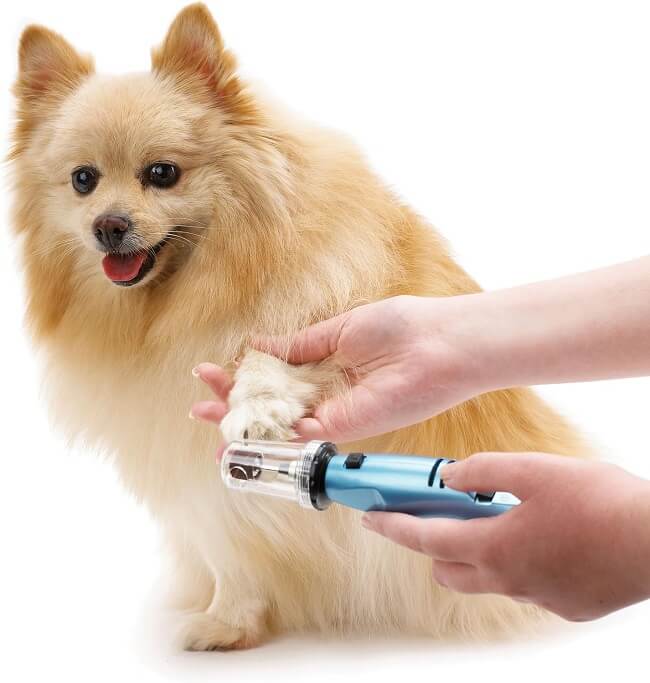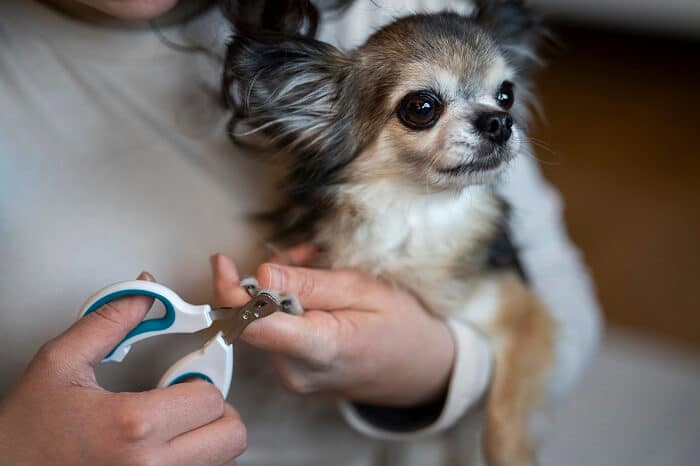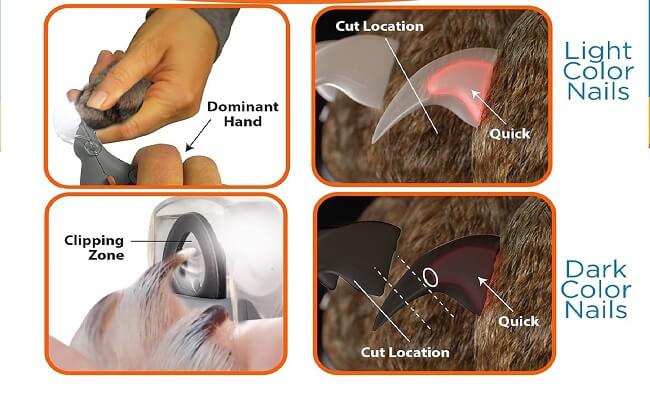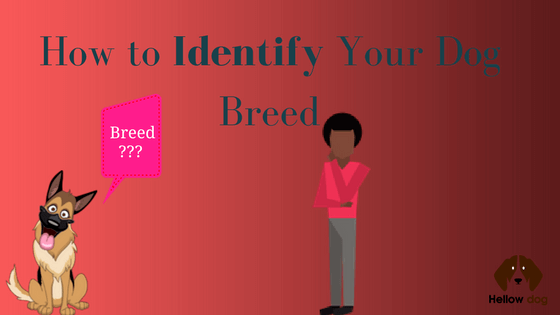Do play sessions with your dog feel more like torture, with their nails digging into your skin? Are you always hearing the click-clack sounds as your dog moves around the house?
Well, guess what? You are not alone!
Many dog owners complain about the frustrating ordeal that dog nails can be, and many vets emphasize the importance of the right tools for grooming dog nails. So today, we’re here to talk about the superstars of dog nail grooming dog nail clippers, and grinders.
We’ll compare the pros and cons of both side by side so that you can make an informed decision about your furry friend’s grooming needs.
So, without further ado, let’s get right into it!

Dog Nail Grinder
A dog nail grinder is a motorized device that uses rotating heads covered in grit to gradually file down a dog’s nails.
This method, while more time-consuming than clipping, can be preferred by some pet owners, especially for dogs with black nails where the quick is harder to see. Grinding results in a smoother, rounded nail tip, which can be more comfortable for the dog.
When using a dog nail grinder, it’s crucial to choose a tool designed specifically for pets to avoid potential injuries from using a too-powerful human nail grinder.
Introducing the grinder to your dog slowly, along with their favorite treats and positive reinforcement, can help them feel at ease with the process.
Pros
- Grinders typically provide a gradual filing process that avoids uneven slices and sharp edges, reducing the risk of getting too close to the quick. Many models also come with guard attachments to protect the sensitive parts of the paw.
- Nail grinders are faster than clippers, allowing for quicker grooming sessions. They also allow greater precision in rounding off the nail tip.
- Grinding heads on nail grinders are easily replaceable once they wear down, unlike clippers that often need to be replaced entirely when dulled.
- Grinding allows for precise shaping of the nails and smoother edges compared to clipping, which can leave rough edges that may be harmful.
- Nail grinders reduce the risk of accidentally cutting the dog, minimizing pain and bleeding for the dog.
- Some dogs may find nail grinders less uncomfortable than clippers, particularly if their nails are sensitive or if the clippers are not sharp.
- Grinding is a suitable option for dogs with thick nails that may be challenging to cut through effectively with clippers.
Cons
- The constant noise and vibrating sensation of nail grinders can be overwhelming for some dogs, causing anxiety or fear. It can make them run and hide during nail trimming sessions.
- Nail grinders are typically more expensive than clippers, and they require replacement grinding heads periodically, adding to the long-term cost.
- Grinding nails can be time-consuming, especially if the dog is not accustomed to the sensation and requires breaks or reassurance during the process.
- The grinding process can generate friction, potentially causing discomfort or burns if the grinder is held in one spot for too long.
- Using a grinder effectively requires training, experience, patience, and a steady hand, making it a more involved grooming technique compared to clipping.

Dog Nail Clippers
Dog nail clippers are special tools used to trim a dog’s nails. They are similar to human nail clippers but are designed specifically for pets. They come in different styles and sizes, including scissor-type clippers, pliers, and guillotine-type clippers, allowing pet owners to choose the most suitable option.
However, using manual nail clippers requires precision and much caution to avoid cutting the quick, which is the pink sensitive part of the nail nerves and blood vessels.
Accidentally,cutting the quick can cause pain and bleeding for the dog. To prevent this, investing in high-quality nail clippers designed for the dog’s nails is extremely important.
Also, styptic powder can help stop bleeding if the quick is accidentally nicked during trimming.
Innovative clippers like guillotine-style nail clippers can make nail trimming easier and more efficient.
Pros
- Nail trimming with clippers can be faster than using a nail grinder, especially for those proficient with clippers, making it a preferred choice for quick and efficient grooming.
- Using nail clippers produces less noise than a nail grinder, which can be beneficial for dogs sensitive to loud sounds. This quieter approach can create a calmer and less stressful environment during nail trimming sessions.
- Nail clippers are generally more cost-effective and require fewer tools and accessories compared to a nail grinder, making them a more economical option for pet owners.
- One key advantage of nail clippers is their precision, allowing for accurate trimming, particularly for dogs with smaller nails or those needing minor adjustments. This precision makes nail clippers suitable for maintaining nail length and shape with greater accuracy.
Cons
- Using clippers increases the likelihood of accidentally cutting into the quick, causing pain and discomfort for the dog.
- Trimming nails with clippers requires a higher level of skill and precision, particularly for dogs with darker nails where it’s harder to see the quick.
- Dull clippers can split the nail, leading to pain and potential infection.
- Clipping can leave sharp corners and rough edges on the nails. These sharp edges can cause scratches and discomfort, especially during playful interactions with the dog.
- Clippers have limited control and cut in only one direction, making it challenging to achieve a specific nail shape. This limitation, coupled with potential discomfort for the dog can make the trimming process less ideal.

Dog Nail Grinder vs Clipper: Which Option is Best and Why?
At the end of the day, the choice between using a dog nail clipper or a dog nail grinder ultimately depends on your dog’s temperament and your comfort level with each tool.
It’s extremely crucial to prioritize your and your dog’s comfort during the grooming process, as many dogs’ can pick up on your anxiety or discomfort, which may affect their reaction.
For dogs who are timid or fearful of loud noises, such as those produced by nail grinders, using clippers may be more suitable. In this case, proceeding slowly and trimming only a small portion of the nail each week is recommended to avoid cutting quickly and causing discomfort. Over time, as the quick recedes, you can gradually trim more of the nail.
Regardless of whether you choose clippers or a grinder, it’s essential to be cautious and avoid cutting a large portion of the nail at once to prevent damage to the quick.
Additionally, using a grinder can help smooth sharp edges and create a more polished finish after clipping.
Moreover, there’s no shame in opting to go for professional groomers if you’re not comfortable or confident in trimming your dog’s nails yourself. Just make sure you can financially sustain budgeting for regular monthly nail trimmings to maintain your dog’s nails.
How Do You Spot the Quick?
Since we talked so much about steering clear of cutting the quick, let us also educate you on how to identify the quick. It’s simple and easy, and as a responsible dog owner, you should know how to identify it.
If your dog has light-colored nails, finding the quick is simple. Hold your dog’s paw gently and look at the nails. You’ll see a pink area in the middle of each dog’s nail – that’s the quick.
For dark nails, it’s harder to see the quick. You can check the underside of the nails for a groove that separates the hard nail from the soft quick. Don’t trim into the soft part. Another way is to shine a light on the nails to see where the quick is.
How Long Should Dog Nails Be?
The healthy length for pup’s nails is approximately 2mm away from the quick, making sure they are trimmed sufficiently but not too close to cause discomfort or bleeding.
Another guideline is to trim the nails so that the quick isn’t exposed but not long enough to touch the ground when your dog is standing. This is the proper nail length without causing discomfort during your dog’s movement and interference with their paws.
Alternatively, aim to keep your dog’s nails short so that it doesn’t touch the ground when standing on a flat surface, as it can lead to orthopaedic problems in the long run.
How Often Should I Groom My Dog's Nails?
Dogs need their nails cut regularly, every 3-4 weeks. However, many owners wait too long between trims, which can cause problems for their pets.
Overgrown nails can hurt the dog and make it hard for them to walk. Long nails might also grow into the paw, which is very painful and might need medical interventions.
Also, long nails can make joints and posture worse. They can get stuck in things or break, leading to injuries.
So, it’s important to cut your dog’s nails regularly to keep them happy and healthy.
Final Words
Deciding between a dog nail grinder and clipper depends on several factors that are unique to each dog owner and their pet. The choice boils down to considerations such as your dog’s temperament, your and your dog’s comfort level with the grooming tool, and, of course, your budget.
Dog nail grinders offer precision and smoothness, reducing the risk of cutting quickly, and are suitable for thicker nails. However, they tend to be noisy and may cause discomfort due to vibrations.
Conversely, dog nail clippers are cost-effective, easy to use, and can be suitable for timid dogs or those sensitive to noise. They can also be combined with a grinder for a smoother finish. However, clippers require skill to avoid cutting quickly and may leave sharp edges if not used carefully.
The best choice is one that aligns with your dog’s needs and your grooming abilities. It’s essential to consider your dog’s personality, tolerance for noise and vibration, and your comfort level before making a decision. If you’re unsure or uncomfortable with providing nail care at home, seeking professional grooming assistance is always an option.







